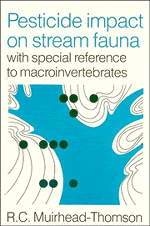Book contents
- Frontmatter
- Contents
- Preface and Acknowledgements
- PART I INTRODUCTION AND ORIGIN OF PESTICIDES IN RUNNING WATERS
- PART II THE ROLE OF LABORATORY AND EXPERIMENTAL METHODS IN EVALUATION
- PART III EVALUATION IN PEST CONTROL PROJECTS
- SIX Introduction to field sampling of aquatic macroinvertebrates in streams and rivers
- SEVEN Impact of insecticides used in control of the spruce budworm
- EIGHT Aquatic environmental effects of insecticides used in tsetse fly control
- NINE Effect on non-targets of larvicides applied to running waters for control of blackfly (Simulium) larvae
- TEN Impact of piscicides (and molluscicides)
- ELEVEN Herbicides and aquatic invertebrates
- Summary and assessment
- References
- Index
TEN - Impact of piscicides (and molluscicides)
Published online by Cambridge University Press: 05 November 2011
- Frontmatter
- Contents
- Preface and Acknowledgements
- PART I INTRODUCTION AND ORIGIN OF PESTICIDES IN RUNNING WATERS
- PART II THE ROLE OF LABORATORY AND EXPERIMENTAL METHODS IN EVALUATION
- PART III EVALUATION IN PEST CONTROL PROJECTS
- SIX Introduction to field sampling of aquatic macroinvertebrates in streams and rivers
- SEVEN Impact of insecticides used in control of the spruce budworm
- EIGHT Aquatic environmental effects of insecticides used in tsetse fly control
- NINE Effect on non-targets of larvicides applied to running waters for control of blackfly (Simulium) larvae
- TEN Impact of piscicides (and molluscicides)
- ELEVEN Herbicides and aquatic invertebrates
- Summary and assessment
- References
- Index
Summary
INTRODUCTION TO FISH TOXICANTS: DEVELOPMENT OF SELECTIVE PISCICIDES
Fish toxicants are widely used to eradicate some or all of the fish in a body of water in order that desirable fish may be stocked, free from predation, from competition or from other interference from undesirable fish. Fish poisons have a long history of use in many countries but it is only in the last 40 years that the subject has really been scientifically investigated, and only within the last 20 that the full environmental or ecological effect of such toxic chemicals has been examined critically, particularly in the US and in Canada. Fish toxicants have been used in all types of water body, both static and running. Earlier progress in their study has been exhaustively reviewed (Lennon et al., 1971), and information available at that time regarding the reactions of freshwater fauna in general, including fish, to those fish toxicants was also the subject of a separate review at that time (Muirhead-Thomson, 1971). In the present review, space limitations would now make it extremely difficult to do justice to the mass of new information covering all freshwater fauna and all types of water body. Accordingly, in keeping with the scope of the coverage, progress since that time will deal only with the use of fish toxicants in running water, and only with the macroinvertebrate fauna at risk.
- Type
- Chapter
- Information
- Pesticide Impact on Stream FaunaWith Special Reference to Macroinvertebrates, pp. 212 - 222Publisher: Cambridge University PressPrint publication year: 1987



